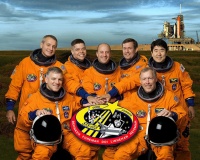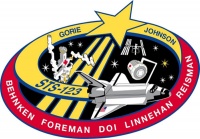STS-123
From The Space Library
 | |
| Organization | NASA-Office of Space Flight (United States) |
|---|---|
| Mission type | Human Crew,Resupply/Refurbishment/Repair |
| Launch date | March 11, 2008 |
| Launch vehicle | Space Shuttle |
| Launch site | Cape Canaveral, United States |
| COSPAR ID | 2008-009A |
| Inclination | 51.6 degrees |
| Experiments | Here |
| Alternate Names | 32699 |
| Additional Information | Here |
| Data Collection | Here |
| Payload Mass Up | 11720.37 kg |
| Payload Mass Down | kg |
| Orbiter | Endeavour |
| Lift Off Mass | 2,055,039.09 kg |
| Orbiter Weight at Liftoff | 121,027.73 kg |
| Orbiter Weight at Landing | 94,404.55 kg |
| Landed | 8:39 p.m. EDT, concrete runway 15, Kennedy Space Center, Fla. |
| Orbits of Earth | 249 |
| Orbital Altitude | Approximately 185 nautical miles |
Contents |
[edit] Crew
- Commander: Dominic L. Gorie
- Pilot: Gregory H. Johnson
- Payload Commander:
- Mission Specialist 1: Richard M. Linnehan
- Mission Specialist 2: Robert L. Behnken
- Mission Specialist 3: Michael J. Foreman
- Mission Specialist 4: Takao Doi, Japan Aerospace Exploration Agency (JAXA)
- Mission Specialist 5:
- Payload Specialist 1:
- Payload Specialist 2:
ISS/Mir Crew Transport
- Garrett E. Reisman - up only Leopold Eyharts, ESA - down only
[edit] Mission
STS 123 is an American space shuttle that was launched from Cape Canaveral at 08:28 UT on 11 March 2008. It transported seven astronauts (six American and one Japanese), a Japanese research laboratory (Kibo) and a Canadian robotic arm (Dextre) to the International Space Station (ISS). It docked with the ISS at 03:49 UT on 13 March. The Kibo laboratory is the first segment of the full laboratory that will be completed during the next two shuttle visits, by STS 124 and STS 127. It will consist of a pressurized unit (length: 11.2 m, diameter: 4.4 m) inside Kibo, and an exposed platform (5.6 m x 5.0 m x 4.0 m). Each of them has a logistic module and can be commanded from Kibo. Dextre is a 1.5 tonne robotic arm with several joints that will do some of the work that otherwise would require spacewalks. Installation of Kibo and Dextre required five spacewalks, including one of seven hours duration for Dextre installation. The 16-day mission ended when the shuttle landed back in Cape Canaveral at 00:39 UT on 27 March 2008.
[edit] EVA
Extravehicular Activity (EVA) conducted by Rick Linnehan, Garrett Reisman, Mike Foreman, and Robert Behnken during five spacewalks for a total of 33 hours, 28 minutes. EVA 1, 7 hours, 1 minute; Linnehan and Reisman prepared the ELM-PS for removal from the space shuttle payload bay. Takao Doi used Canadarm to move the ELM-PS to its interim location on the zenith port of Harmony. The ELM-PS was relocated to its permanent location after the arrival of the Pressurized Module on space shuttle mission STS-124. Linnehan and Reisman also worked on the initial assembly of the Special Purpose Dexterous Manipulator, also known as "Dextre," installing both orbital replacement unit/tool changeout mechanisms (OTCMs), the "hands" of Dextre's arms. EVA 2, 7 hours, 8 minutes; Linnehan and Foreman attached the two arms of Dextre. EVA 3, 6 hours, 53 minutes; Linnehan and Behnken finished assembly and installation of Dextre. EVA 4, 6 hours, 24 minutes; the major focus of this spacewalk by Behnken and Foreman was a demonstration of the Tile Repair Ablator Dispenser, a caulk gun-like device. A substance called Shuttle Tile Ablator-54 (STA-54) was applied to intentionally damaged heat shield tiles, which were returned to Earth for testing to determine how STA-54 performed in both a microgravity and vacuum environment. EVA 5, 6 hours, 2 minutes; Behnken and Foreman installed the Materials International Space Station Experiment - 6 (MISSE-6) and inspected the station's right Solar Alpha Rotary Joint, where metal shavings had previously been discovered.
[edit] Payload
ISS Assembly Flight 1J/A; Kibo Japanese Experiment Logistics Module - Pressurized Section (ELM-PS) and Canadian Special Purpose Dexterous Manipulator; crew exchange
[edit] Books about the Space Shuttle Program
Buy This Book Click here |
Buy This Book here |
Buy This Book Click here |
Buy This Book Click here |





